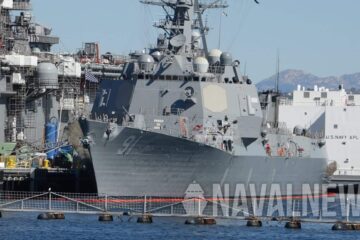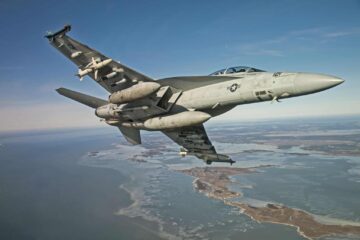The NMESIS was tested to see if it will fit in the confines of the hangar, drive up the vehicle ramp leading to the Flight Deck, and fit and drive through the vehicle doors of the amphibious ship. The NMESIS will form a key component in U.S. Marine Corps’ Commandant General David Berger’s Force Design 2030 strategy to counter peer nation shipping in the Indian Pacific Command (INDO-PACOM) region with stealthy sea-skimming programmable and survivable Anti-Ship missiles.
The United States Marine Corps’ (USMC) Navy Marine Expeditionary Ship Interdiction System (NMESIS) is an unmanned 4×4 wheeled Joint Light Tactical Vehicle (JLTV) that can transport two stealthy 100+ kilometer Naval Strike Missiles (NSMs) for Anti-Ship Area Denial Missions. Being able to drive itself by remote control, the NMESIS increases U.S. Marine battlefield survivability and concealment and is also able to fire remotely.
The USMC intends to field NMESIS by FY2023 as a counter to amphibious assaults and adversary shipping in the INDO-PACOM and Asian Pacific Rim (RIMPAC) region.
The JLTV NMESIS is also able to be transported via U.S. Navy Landing Craft Air Cushion (LCAC) and Surface-to-Shore Connector (SSC) hovercrafts and small utility boat connectors, inside a USMC KC-130 cargo plane, and slung underneath a USMC CH-53K heavy-lift helicopter. The NMESIS JLTVs should be able to be embarked and deployed from the upcoming Light Amphibious Warships (LAW) that are intended to cruise the RIMPAC region on missions lasting around thirty days with 75 Marines and their associated vehicles embarked aboard.

By deploying USMC’s NMESIS and High Mobility Artillery Rocket Systems (HIMARS) on various ships and islands in the INDO-PACOM region, the USMC hopes that these Long-range Precision Fires (LRPF) rocket and missile systems will act as an effective land and ship-based deterrent against any hostile invasion force. HIMARS has been tested to be able to fire from the Flight Deck of amphibious transport ships.
One-thousand-plus-mile Tomahawk cruise missiles fired from land-based trailers is also a LRPF possibility if the funding comes through for trailer-based Tomahawk vertical launch missile development and acquisition, as are other possible missile and rocket warhead options in development.

Naval News has also covered the logistics involved in resupplying and rearming the NMESIS system.







